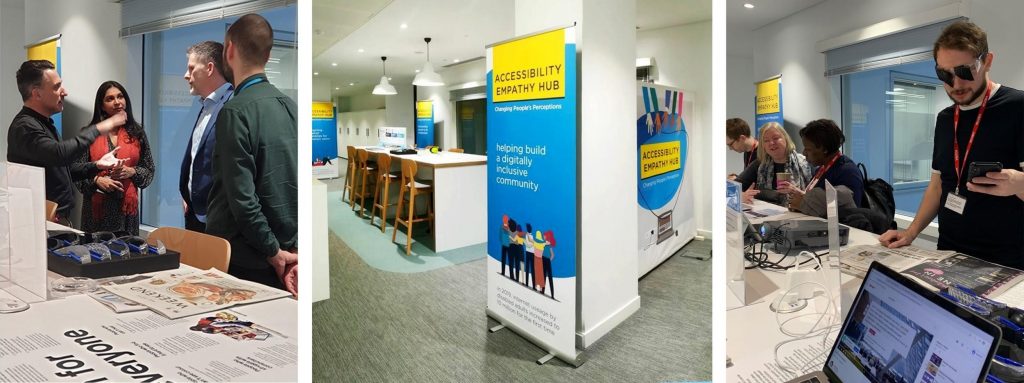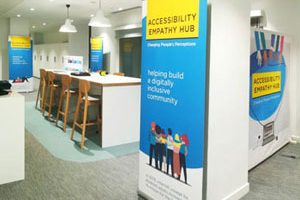https://lifeathmrc.blog.gov.uk/hmrc-accessibility-empathy-hub/
HMRC Accessibility Empathy Hubs
 Everyone has a part to play in ensuring that the content and digital services we provide to our customers and colleagues are accessible.
Everyone has a part to play in ensuring that the content and digital services we provide to our customers and colleagues are accessible.
HMRC has set up Accessibility Empathy Hubs to demonstrate the barriers that disabled people can face.
We want to inspire you to think about the role you play in a new, more accessible way. Even if you are not involved in the development of digital services or websites, you can still help improve the accessibility of documents that we create and share.
Why accessibility is important
A fully inclusive government service is one that can be accessed and successfully completed by all its users. They will be able to interact however they need to, regardless of their personal characteristics, situations, capabilities or access needs.
There are many benefits to designing and building inclusive services.
- Providing an accessible service will result in a better experience for everyone, not just our disabled customers
- We will be meeting our legal requirements
- Equality Act 2010, we have a legal obligation to provide equal access to people with disabilities
- Public Sector Accessibility Regulations 2018, we have a duty to be proactive in making things accessible
- It’s more cost-effective if all users can use a single digital service rather than developing multiple, costlier services catering for specific needs
- By thinking about accessibility and inclusion from the start you can avoid costly rework at the end of a project
Accessibility Empathy Hubs
 To demonstrate the barriers that disabled people can encounter we have created an Accessibility Empathy Hub in London, 10 South Colonnade, open area 7.21 and in Newcastle, Benton Park View.
To demonstrate the barriers that disabled people can encounter we have created an Accessibility Empathy Hub in London, 10 South Colonnade, open area 7.21 and in Newcastle, Benton Park View.
We have different areas set up. Each one has a set of tasks you can carry out that will show various barriers that exist for someone with a disability.
- Chromebooks are installed with the 7 Government Digital Service (GDS) accessibility personas. Each persona simulates at least one disability or impairment which can cause difficulty when trying to use a digital service
- We have glasses that simulate different visual impairments. For example, common conditions such as Glaucoma; age-related Macular Degeneration; patchy vision which can be a complication of Diabetes
- There are ear defenders to experience the effects of severe hearing loss and the difficulties this can cause
Normally you would be able to come along to the Accessibility Empathy Hubs however, while we are working under COVID-19 restrictions they are temporarily closed.
So we have published some activities that could be done at home on our raising accessibility awareness page and compiled a few YouTube playlists .
We’ve had lots of great feedback from visitors.
Resources used to create our HMRC Accessibility Empathy Hubs
To set up our Chromebooks we followed the guidance from Government Digital Service (GDS) accessibility team to create the seven accessibility personas.
Examples of the printed material we created can be found at posters and banners in the HMRC Accessibility Empathy Hubs. If you are creating your own accessibility empathy hub in your Department and want to know more about what we did, email us at accessibility.team@hmrc.gov.uk.
Accessibility in numbers
To show how important it is for us to think about accessibility from the start we have collated a few statistics.
- 70+% of conditions relating to disabilities aren’t visible (from Microsoft Office 365 YouTube)
- 7 in 10 disabled customers with access needs will click away from a website they find difficult to use. Only 1 in 10 will make a complaint about it (from Barclays Corporate Banking YouTube)
- It is estimated that 6.4 million people in the UK (10% of the population) have dyslexia (from NHS website)
- 700,000 people in the UK are on the autistic spectrum (from National Autistic Society)
- Over 2 million people in the UK live with sight loss. 350,000 are registered blind or partially sighted (from RNIB website)
- 10 million people in the UK have arthritis (from NHS website)
- 145,000 people have Parkinson’s (from Parkinson’s UK)
- 11 million people in the UK have some kind of hearing loss. 900,000 of these have severe or profound hearing loss (from Hearing link)
- 10% of civil servants have declared they have a disability. In HMRC 9% of staff (5721 people) have declared they have a disability (from Institute for Government, as of 31 December 2019 and HMRC's HR as of March 2020)
Where the barriers and issues exist
The design for everyone poster details the following barriers that people face as a result of their disabilities and how we can address them:
- who find it hard to understand
- who need custom design
- who aren’t online
- in distracting situations
- using screen readers
- who find it hard to read
- who can’t talk
- who can’t see colour
- who struggle with computers (due to inexperience or medical conditions)
- who find it hard to see
- who can’t hear
Disabilities may be permanent, temporary or situational and to be inclusive we need to deal with all circumstances.
Please email us at accessibility.team@hmrc.gov.uk if you have any questions or want to know more.